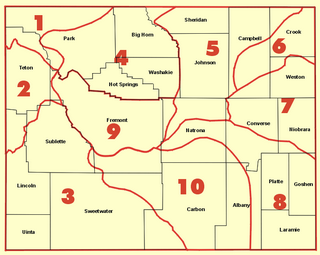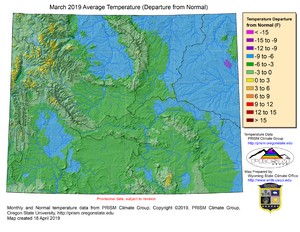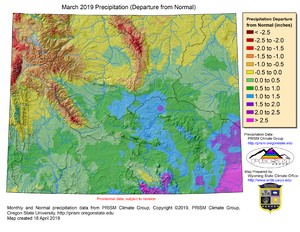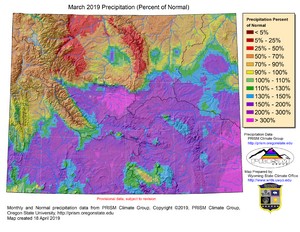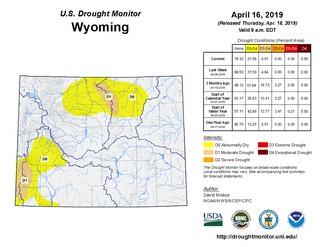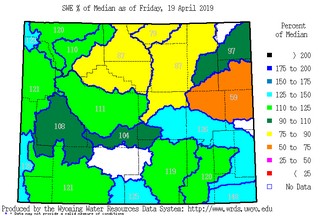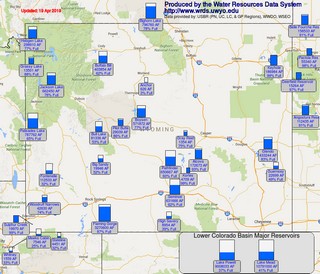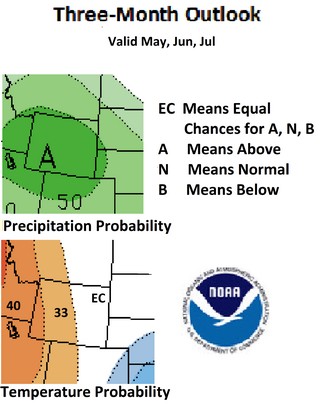 | |
 | |
| WRDS/SCO is currently working remotely so there may be a slight delay returning phone calls. Please email wrds@uwyo.edu if you are in need of information and we will respond as soon as possible |
|
| ||||||||||||
Drought Impacts and Outlook Summaries - 25 Apr 2019View this Summary as a PDF
Highlights for the State
Drought D1 conditions in Uinta County improved slightly but expanded farther northward in Lincoln County. D0 was also removed from most of Fremont and Hot Springs Counties, leaving a drought-free area between the Upper Green and the Bighorn River Basins. All but the extreme southeastern part of the Wind River Reservation was in D0 on 01 March but is now drought-free. Unfortunately, owing to poor snowpack conditions in north-central Wyoming, D0 expanded further east of the Bighorn Mountains to cover much of Sheridan and Johnson Counties as well as the western part of Campbell County. Conditions in the Bighorn Mountains have degraded enough that the higher elevations are now in D1 (Moderate Drought). With greater chances for above-average precipitation and with low evaporative demand across affected areas in southern Wyoming, further improvement in the southwest is expected.
Snowpack Compared to conditions at this time last year, snowpack is still less in the north than it was while the southern half is generally at a higher percentage of median. Additional products can be found at: http://www.wrds.uwyo.edu/sitemap.html Do you have drought impacts to report? We need your on-the-ground reports and you can input them here: http://droughtreporter.unl.edu/submitreport/
Water Resources Reservoir conditions may be viewed online in larger format at: http://www.wrds.uwyo.edu/surface_water/teacups.html Downstream, Lake Mead continues to hold at around 41% capacity while Lake Powell has declined another percent since the beginning of March. The map below shows reservoir conditions in Wyoming as of 19 April.
Weather and Climate Outlooks Moving into May there are slightly better chances for above-normal temperatures in the northwest while the remainder of the state has unclear signals. For precipitation, the better chances for above-normal amounts are in the southern two-thirds of Wyoming while the chances in the northern third, though still favoring above-normal amounts, are not as strong. Looking at the May thru July timeframe, the best chances for above-normal temperature are in the western quarter of the state with slightly elevated chances existing for the remainder off the western half. The signal is too weak in the eastern half of the state to make a determination for above, below, or average temperature. The signals are much stronger for precipitation with the odds being at better than 50% for above-normal precipitation throughout almost all of Wyoming. With chances being favorable long term for above-normal precipitation, it is expected that drought conditions, especially in the southwest will continue to improve.
Heard around the State Natrona Co., Apr 07: "The ground finally thawed, but just below the surface it is very wet. Our reservoir is completely thawed." Platte Co., Mar 25: "Ground is pretty wet in places due to snow melt, but it is going into the ground, no runoff." Sheridan Co., Mar 22: "Clear Creek has opened up partially flowing over submerged ice sheets. Most of the ground is bare and starting to thaw. Two yearling White Tail twins just walked by." Washakie Co., Mar 02: "Piles of plowed and shoveled snow still exist. Sidewalks and areas not previously cleared are icy and treacherous!"
Partners
Stay Tuned and In Touch Live in or around the Wind River Indian Reservation? Check out the Wind River Indian Reservation and Surrounding Area Climate and Drought Summary at: WindRiverRes-Climate-Drought-Summary-Mar2017.html |
||||||||||||



